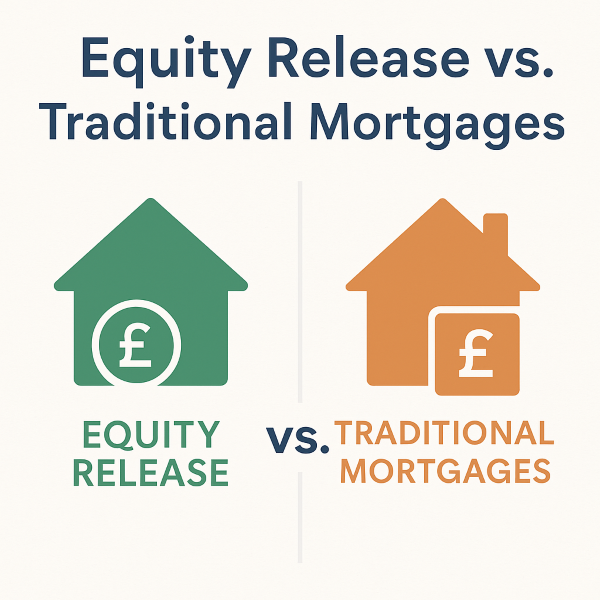Equity release allows homeowners to unlock a portion of their property’s value without the need to sell. This option provides either a tax-free lump sum or regular income based on individual needs and preferences. It’s a popular solution for those seeking to supplement their finances, particularly in later life.
Equity release in the UK mainly involves two types of products: Lifetime Mortgages (LTMs) and Payment Term Lifetime Mortgages (PTLMs). LTMs are accessible for individuals aged 55 or older, while PTLMs are available from the age of 50. Both schemes are designed to help homeowners access funds tied up in their homes while retaining ownership.
These products operate by securing the borrowed amount against your property’s value. You can choose to repay interest regularly or let it roll up, which will be settled when the property is sold. It’s important to note that with reputable equity release plans, you’ll never owe more than your home’s value.
How Does Releasing Equity Work?
Releasing equity involves two main types: lifetime mortgages and home reversion plans. Each works differently but offers unique benefits.
A lifetime mortgage is a loan secured against the value of your home. This loan is repaid from your estate, typically by selling the property after your passing. Your estate will have up to 12 months to repay the amount owed. The repayment will never exceed the property’s value, offering some financial protection.
With a home reversion plan, you sell a share of your property’s value, usually between 25% and 100%, to a provider. In exchange, you receive a cash lump sum, regular income, or both. These plans are generally available to individuals aged 60 and over.
Eligibility for Equity Release
Not everyone qualifies for equity release. Lenders may decline applications due to insufficient equity, poor credit history, or unsuitable property types, such as homes with thatched roofs. These factors can influence whether your application is approved.
Costs and Considerations
Equity release products come with setup costs, varying depending on your provider. For more information, explore articles about equity release costs and interest rates. Depending on their financial situation, some people may consider remortgaging with a standard mortgage.
Equity release is not a decision to take lightly. It can impact your entitlement to means-tested benefits and is a long-term financial commitment. Professional advice from a qualified financial adviser is mandatory when considering these products. This ensures you fully understand the implications and whether it suits your needs.
How Long Does Equity Release Take?
The equity release process usually takes between eight and twelve weeks. However, the timeline can vary depending on the product selected.
The initial step involves consulting a financial adviser. This ensures equity release suits your needs and helps identify the best provider and product. Once decided, your application can be submitted.
After submitting your application, your provider will arrange a home valuation. You will also need to appoint a solicitor. Selecting one experienced in equity release is advisable, as this helps prevent or minimise delays.
Delays may occur if certain issues arise, such as:
- Your property is not being registered with the Land Registry.
- An Enduring or Lasting Power of Attorney is in place.
- The property is leasehold or part of a trust.
- Complications with your buildings insurance schedule.
Your solicitor will handle these matters, ensuring the process stays on track. Once all legal checks are complete, you will receive a completion date. At this stage, legal fees will need to be paid.
By addressing potential issues early, the process can often proceed smoothly. Proper guidance from professionals is key to avoiding unnecessary delays.
How Does Equity Release Work When You Die?
The process for equity release after death depends on the type of product you selected. It also matters if you are the last surviving borrower residing in the home. If no one else will live in the property, here’s how it works:
With a lifetime mortgage, the loan becomes repayable by your estate. This typically involves selling the property to cover the outstanding balance. The estate will usually have 12 months to complete this process. Importantly, the amount repaid will never exceed the property’s value, offering protection to your heirs.
The provider owns a share of your property for a home reversion plan. The provider will generally require the property to be sold upon your death. The sale proceeds will settle their share, and any remaining funds will go to your beneficiaries.
In both cases, your beneficiaries receive any remaining funds after debts are cleared. However, they may not gain the property’s full value. They may need to repay the equity release amount if they wish to keep the property.
If you opt for a lifetime mortgage, consider borrowing a lower sum and adding inheritance protection. This feature ensures a fixed portion of your property’s value is reserved for your heirs. Knowing they will receive a guaranteed amount after your passing can provide peace of mind.
Equity release offers financial flexibility but requires careful planning to protect your estate’s value. Ensure you fully understand the implications before proceeding.
What should I do next?
Talk to Richard
Thank you for reading our “How Does Equity Release Work? | Ask Richard, publication. Stay “Connect“-ed for more updates soon!






